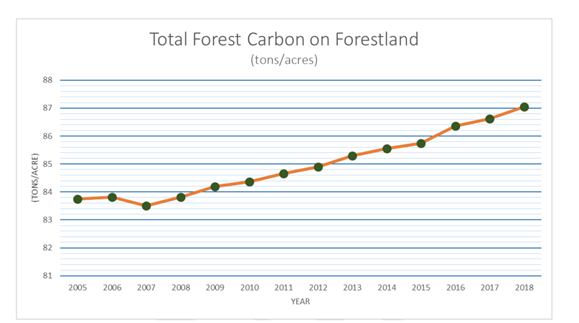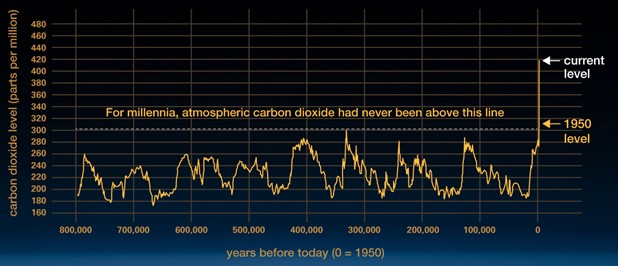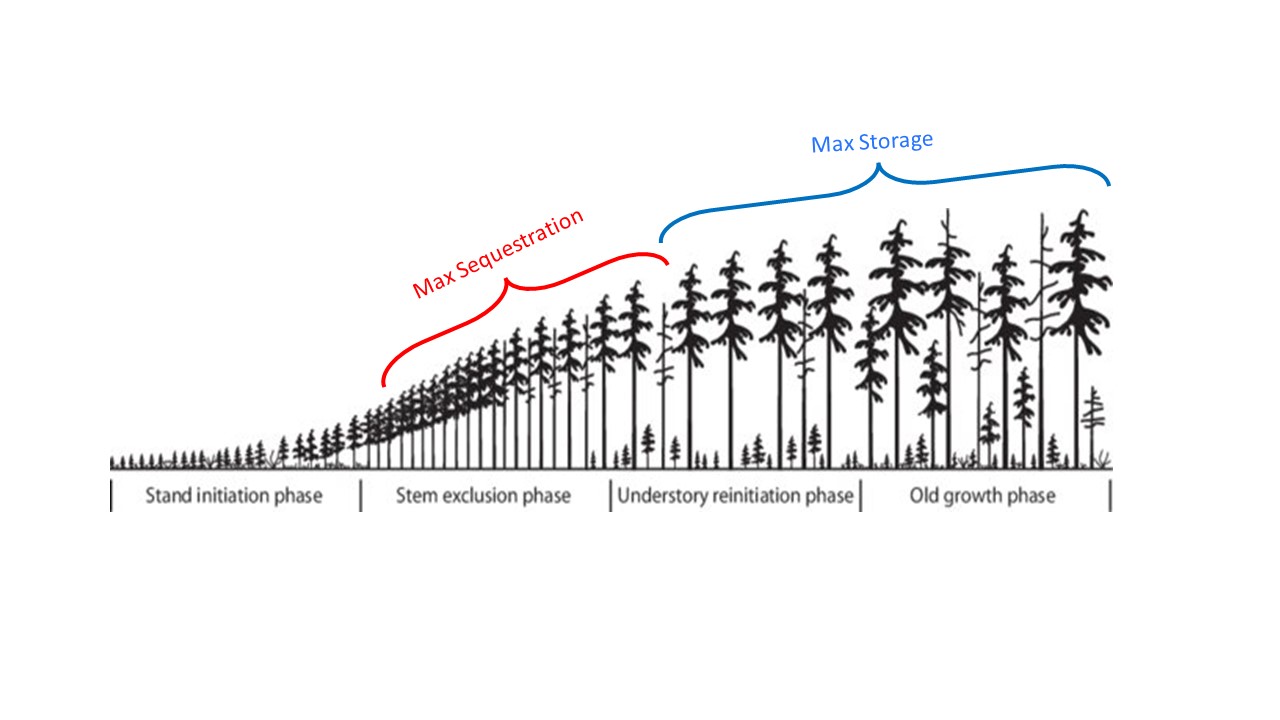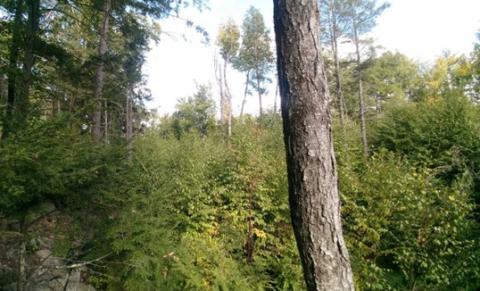Managing Forests for Carbon, Resiliency, and Wildlife Habitat
Forest Carbon
Forests play an important role in the fight against climate change due to their ability to remove carbon dioxide (C02) from the atmosphere and store carbon for long periods of time. In places like New Hampshire, where forest growth is outpacing forest harvesting by a ratio of 1.8 to 1 (USDA FIA, 2020 data), forests act as a carbon sink, which means they remove more carbon from the atmosphere than they emit. In New Hampshire, the total amount of forest carbon increased steadily between 2007 and 2018 (Figure 1., NH Forest Action Plan, 2020)

Figure 1. Total forest carbon per acre in New Hampshire, 2005 to 2018 based on USDA Forest Service FIA data (source: New Hampshire Forest Action Plan – 2020)
However, where forestland is converted to non-forest use, or where forests have been devastated by wildfire, forests can act as a carbon source, which means carbon emissions are greater than carbon removals. Although burning fossil fuels is by far the largest source of anthropogenic greenhouse gas (GHG), the contribution of forest loss is a significant source of global GHG according to the most recent report by the International Panel on Climate Change (IPCC 2022). For this reason, reforestation, afforestation, and the use of durable wood products sourced from sustainably managed forests have been identified as important strategies to help reduce CO2 from the atmosphere. Moreover, additional climate benefits can be achieved when wood products can be used as substitutes for more carbon-intensive materials (e.g. steel and concrete).
Storage vs Sequestration
Preventing forest loss, increasing the amount of forestland, and practicing sustainable forestry are important strategies to combat climate change. However, there is increasing interest in managing forests either specifically for carbon or managing forests using carbon-informed practices. Before we can think about what carbon-informed forestry practices might look like, we must understand some of the nuances of forest carbon and stand development.
First, we need to distinguish between carbon storage, which refers to the amount of carbon in a forest at given point in time, and carbon sequestration, which refers to the rate at which carbon is removed from the atmosphere within a given time frame, normally a single year. Both carbon storage and sequestration have climate benefits. The benefit of carbon storage is that large amounts of carbon are effectively locked up in various carbon pools, including above-ground biomass (trunks, branches, leaves), below-ground biomass (roots), downed dead wood, and forest soils. Simply put, carbon stored in forests is carbon that is not in the atmosphere. On the other hand, the benefit of carbon sequestration is the removal of CO2 from the atmosphere, which is important because the concentration of CO2 in the atmosphere is at unprecedented levels (Figure 2):

Figure 2. Atmospheric CO2 concentration over time (Source: climate.nasa.gov)
The distinction between storage and sequestration is important because they are maximized at different stages of forest development. On a per-acre basis, carbon storage is maximized in mature and older growth forests that feature large diameter trees and lots of downed dead wood, whereas carbon sequestration is maximized in relatively younger forests that are between 30 and 70 years old that contain a high density of pole-size and small sawtimber size trees per acre. Those dense, younger stands sequester more carbon per acre because there are many more trees per acre growing in high competition with each other, and thus forest growth is rapid. On the other hand, as a forest matures, some trees will naturally succumb to mortality due to competition and self-thinning. Other trees will survive but will become overtopped by the most vigorous trees that reach dominant canopy positions. The overtopped trees will grow more slowly. Thus, an older stand has fewer trees per acre, as well as overtopped trees whose growth rates are greatly reduced, resulting in an overall reduced rate of carbon sequestration per acre. However, given the volume in large trees of older stands, as well as the increased biomass in underground root system and down dead wood, older forests have greater carbon storage per acre (Figure 3).

Figure 3. Maximizing forest carbon sequestration occurs earlier in stand development while maximizing carbon storage occurs later
A Balancing Act
So, what should we manage for – maximizing sequestration or maximizing storage? Ultimately, a balanced approach that seeks to maintain areas of young, fast-growing forests that can help maximize sequestration while allowing other forests to grow to old age to maximize storage is recommended. Of course, this approach requires that mature forests are occasionally harvested to maintain a component of young forest on the landscape. However, if the harvest produces durable wood products that continue to store carbon during their useful life and beyond (in landfills), the impacts to carbon storage are mitigated. Further, if those products can replace steel, concrete, or plastic, the climate benefits are further enhanced. Ultimately, we need to be cognizant of the greater landscape in our harvest decisions.
Forest Resilience and Climate Adaptive Management
Although forests can help reduce the impacts of climate change through carbon storage and sequestration, it’s important to recognize that forests are being negatively affected by climate change (Ontl et al. 2020). In other words, the ability of forests to provide the goods and services that society demands, including storing and sequestering carbon, is threatened by the effects of climate change on our forests. For example, as the climate continues to warm, we will likely experience greater frequency and severity of droughts, intermixed with fewer, but more intense rain events. Future weather patterns and climate will deviate from the norm, and therefore will cause stress on trees to varying degrees depending on individual species’ tolerances to these changes. In turn, many pests target weakened trees and stress trees, which can increase the threat of insect and pathogens, reducing overall forest health. Moreover, as winters become milder, invasive pests such as the hemlock woolly adelgid whose populations might otherwise be controlled by harsh winter temperatures will be able to survive and spread further north.
Given the uncertainty around climate change, and the negative effects it will have on our forests, adopting climate-adaptive management strategies that improve forest resilience is critical. Ultimately, strategies to increase resilience center on diversifying tree and shrub species, promoting trees of good health and vigor, and managing for multiple ages across a property or landscape. The rationale for species diversification is to mitigate against pests and pathogens that target a specific species. In other words, growing multiple species reduces the impacts of losing any one species to some future pest or pathogen. Similarly, having areas of young forest full of relatively smaller trees can help hasten recovery following a major wind event, such as a hurricane, which would have a greater effect on large, mature trees that are greater risk of blowing over. A balance of young and old forest, and a diversity of species can help mitigate the effects of climate change on our forests by increasing forest resilience.
Wildlife Habitat
In general, we can increase the diversity of wildlife species in within a given area and across the landscape by increasing the diversity of habitat types. With respect to forests, this often means having a mix of forest types (northern hardwoods, oak pine, hemlock, flood plain forest) and forest ages. Having trees of different ages and heights within the same forest stand can increase vertical structure or forest layers, that can support a greater variety of species. Thinking horizontally across a landscape, having large blocks of mature forest interspersed with patches of young, dense, shrubby forests, and large grassy fields, will provide a variety of habitats that different species will occupy. Striking a balance between young and old forests with an eye on maintaining structure and important features, such as dead standing trees, can benefit a diversity of wildlife species, while also creating a more resilient forest. If you haven’t already, watch the video presentation by Matt Tarr that discusses how silviculture can be used to maintain and enhance wildlife habitat.
Co-benefits and Tradeoffs
In general, we must keep forests as forests, and apply management strategies that seek to balance multiple benefits (i.e. carbon, timber products, recreation, wildlife habitat, etc.). We must consider large temporal and spatial scales and seek to implement tactics that help forests adapt to our changing climate. Numerous management activities and strategies have co-benefits across a variety of management goals, including climate adaptation, carbon, wildlife, and timber. A recent paper by Todd Ontl and others highlights many examples these co-benefits (Ontl et al. 2020).
However, at small spatial scales, it is inevitable that certain trade-offs will arise. For example, harvesting a stand of mature northern hardwoods can create early successional habitat that benefits certain wildlife species, however that cut stand will reduce carbon storage at the stand level (Littlefield and D’Amato, 2022). Nevertheless, at landscape scales, having a mix of early successional habitat can help achieve a balance between managing for carbon sequestration and carbon storage, while also diversifying habitat (Figure 4).
Overall, society asks a lot of our forests – recreation, timber products, wildlife habitat, and, increasingly, carbon. However, managing forests exclusively for a single purpose tends leads to a homogenized forest. Ultimately, seeking an approach that promotes a healthy forest capable of storing and sequestering carbon while also providing critical wildlife habitat and producing wood products can be achieved if we are thoughtful about our management activities and are cognizant of the effects of management decisions over long periods of time and at landscape scales.

Figure 4. A recently harvested stands that shows young forest within a canopy gap adjacent to mature forest.
References:
Littlefield CE, D'Amato AW. Identifying trade‐offs and opportunities for forest carbon and wildlife using a climate change adaptation lens. Conservation Science and Practice. 2022 Apr;4(4):e12631.
Ontl, T.A., Janowiak, M.K., Swanston, C.W., Daley, J., Handler, S., Cornett, M., Hagenbuch, S., Handrick, C., McCarthy, L. and Patch, N., 2020. Forest management for carbon sequestration and climate adaptation. Journal of Forestry, 118(1), pp.86-101.
International Panel on Climate Change [IPCC]. 2022. Climate Change 2022: Mitigation of Climate Change. Available online: https://www.ipcc.ch/report/ar6/wg3/downloads/report/IPCC_AR6_WGIII_Full_Report.pdf (last accessed 10/1/22).
NH Division of Forest and Lands (2020). New Hampshire Forest Action Plan. Accessible online: https://www.nh.gov/nhdfl/documents/nh-stateforestactionplan_2020.pdf (las accessed 10/1/22)

